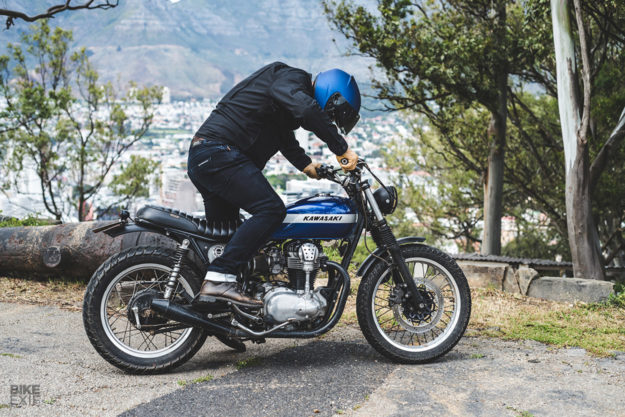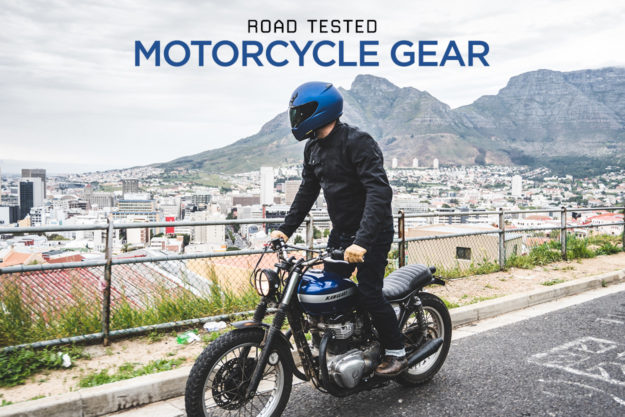
Today I’m breaking down three pieces of gear that have very quickly become staples in my closet. Say hello to the helmet that’s converted me to modern lids, a jacket that I’d wear to meetings, and my new favorite jeans.
Let’s dive right in…
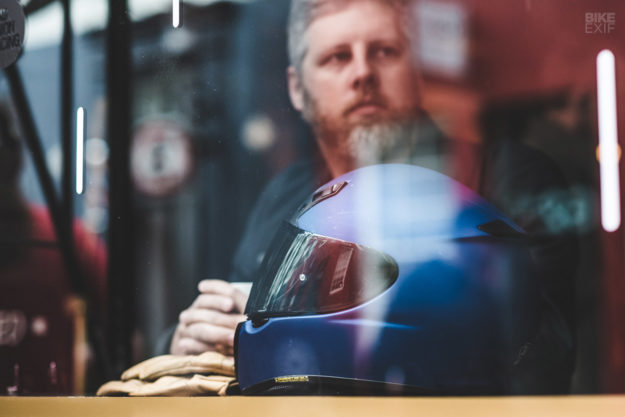
Shoei RYD [RF-SR] Helmet I’m a dyed-in-the-wool retro helmet guy. Call me a hipster or a slave to fashion, but I really like simple, stylish helmets in classic styles, and I think they suit the bikes we feature here more than modern lids do.
Here’s the problem though: retro helmets are great for cruising around on scramblers or cafe racers. But on faster bikes, or over longer distances, they pretty much suck. They’re noisy, not very aerodynamic, and often don’t vent well. So when I got an invite to tour Eastern Europe on a bagger, I knew none of the old-school helmets in my humble collection were going to cut it. Luckily Shoei Helmets UK came to the rescue, hooking me up with the new Shoei RYD (sold in the US as the RF-SR, with a breath guard).
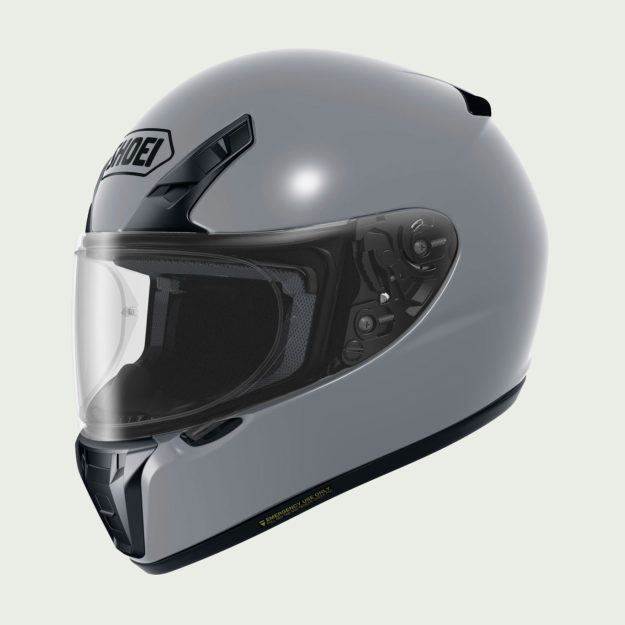
Let’s get this out the way immediately: I love this helmet, and I’m not ashamed to admit that that’s fifty percent down to its looks. Shoei kept the RYD’s aesthetic subtle and understated, with a lack of excessive contours, and proportions that are vaguely reminiscent of old racing helmets. So it cuts a neutral silhouette that complements my Kawasaki W650 as much as the Ducati Monster 797 I was hooning around on the other day.
The RYD comes in at £350, and is only available in solid colors. I opted for the matt blue metallic finish paired with a tinted visor, and was floored by how good it looks in the light of day. The combination of metallic paint and a matt finish is every bit as stunning as it sounds, and the overall build quality is stellar. (But be warned—that matt finish is a real pain to keep clean.)
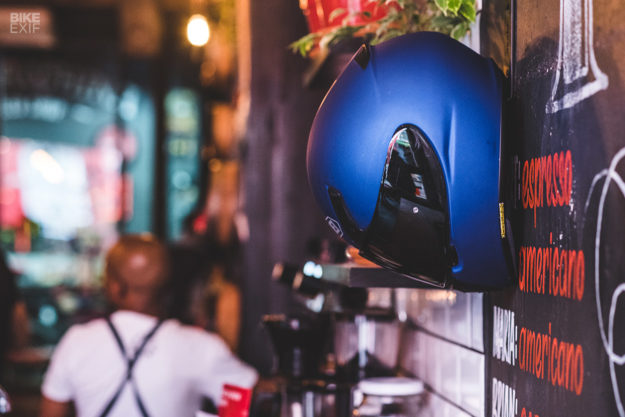
The other half of my love for the RYD is all about how good it feels. My pip measures 62cm, which puts me at an XL for most manufacturers, including Shoei. Straight out of the box the XL RYD fit snug and comfortable, with no hotspots and no need to break it in. The interior might not feature the sort of quilted leather touches that you’ll find on high-end retro helmets, but it has marshmallow-like levels of plushness.
It’s also removable and washable, and the cheek pads have a quick release system to help medical personnel get your helmet off safely in an emergency. I don’t use a Bluetooth comms system myself, but it looks like there’d be enough space to fit one, and I can get my sunglasses on without much fuss.
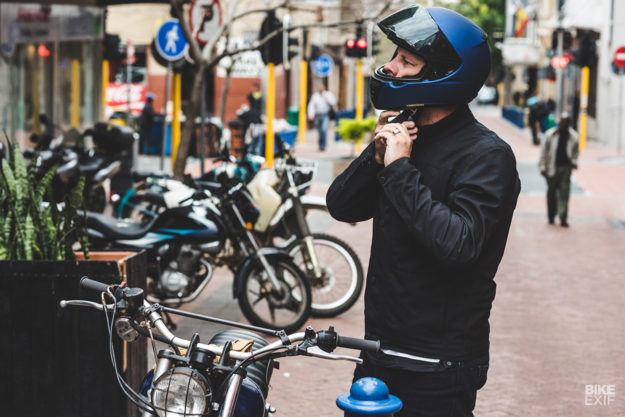
The outer shell uses Shoei’s ‘Advance Integrated Matrix Plus’ design, which is basically just a mix of fiberglass and organic fibers, but makes for a pretty svelte helmet at a hair under 3 lbs. There’s also a multi-density EPS liner, and it’s probably worth noting that Shoei use four shell sizes across the size range, which is reassuring for riders with smaller heads. Keeping the helmet in place is a standard issue double D-ring system, padded for comfort and kitted with a press-stud for stowing the end of the strap.
Plush and light are two major boxes to tick, but the RYD also scores high in other areas. It’s pretty quiet, even on naked bikes, with little to no buffeting at speed. It’s well ventilated too, with three front vents (one at the chin and two up top) that are all easy to operate with gloves, and two ‘spoiler’ exit vents at the back.
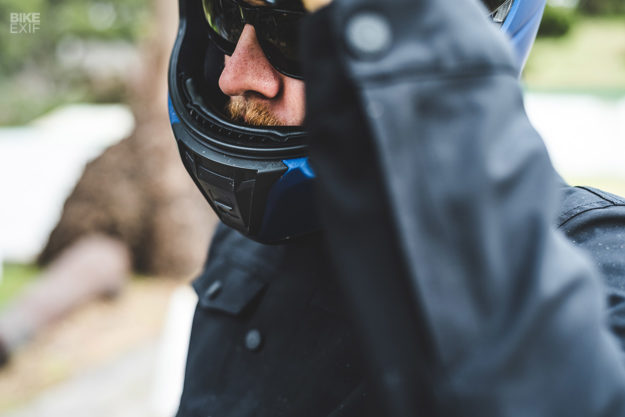
Noise levels are obviously a touch elevated with the vents open, but not unbearably so, and there’s a little chin curtain too to help keep things peaceful.
The visor is another standout feature: It’s the same CWR-1 shield used on Shoei’s RF1200 and NXR helmets. The eye port is nice and wide, there’s zero optical distortion, and the anti-fogging Pinlock system is highly effective, even when stuck at traffic lights.

The visor goes up and down in incremental clicks, and clips closed via a neat carbon fiber notch on the left. It also forms a pretty tight seal: there’s a clever spring-loaded hinge system that ‘hugs’ it against the helmet. Swapping shields is insanely easy, and as a bonus, the base plate that the shield attaches to on each side is carbon fiber.
Any nitpicks? Yes, one: I don’t like the look of the top vents. I think the aggressive ‘V’ shape messes with the RYD’s subtlety. But that’s my only gripe, and it hasn’t stopped the RYD from becoming my go-to helmet on any bike. [Buy]
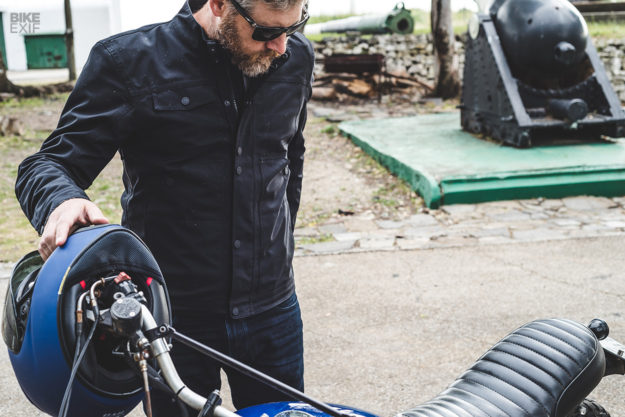
Aether Apparel Rally jacket Aether’s approach to motorcycle gear is the same as its technical apparel. The LA-based company makes high-tech, highly functional stuff, with minimalist styling. And that philosophy is in full effect in their new Rally jacket.
It’s fully waterproof and armored—as you’d expect at $550. Fortunately everything feels primo, right down to the packaging. My Rally came neatly folded in a suit bag, wrapped in black tissue paper, with the relevant paperwork and Aether’s ‘Journal’ stashed in a zippered pouch. I realize this might seem frivolous to some, but it makes for a wicked first impression. Other cute touches included an emergency whistle, and a small aluminum key ring stash tube with a pair of earplugs.
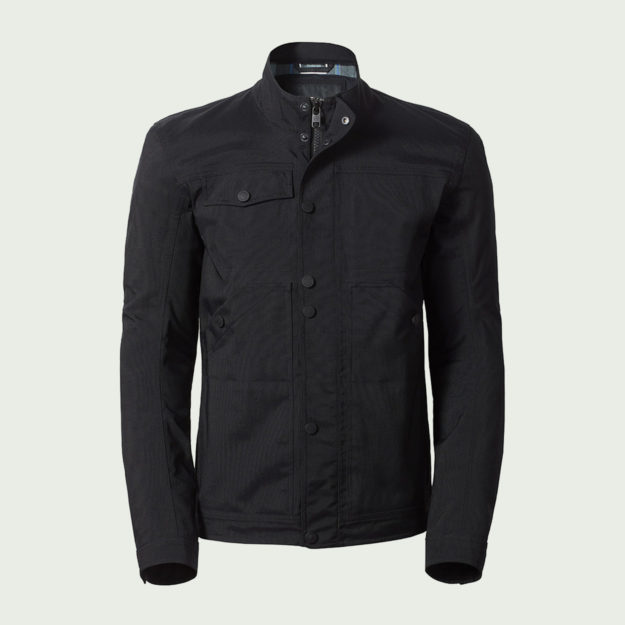
More notably, there was also a full complement of D3O® armor in the box, including EVO XT elbow and shoulder pads, and a Viper ST back protector. Aether did a great job with the pockets for these, and getting everything in (and out) was a cinch. Also included: Aether’s lifetime guarantee, something you seldom get with bike gear.
The Rally jacket’s outer shell is a three-layer abrasion-resistant nylon. It’s seam-sealed to be fully waterproof and wind-resistant without the need for any additional liners. (Since Cape Town’s currently experiencing a drought, I haven’t yet been able to test the Rally in adverse conditions, but I’ve put many rainy miles into Aether’s similar Skyline jacket and it’s held up for the most part.)
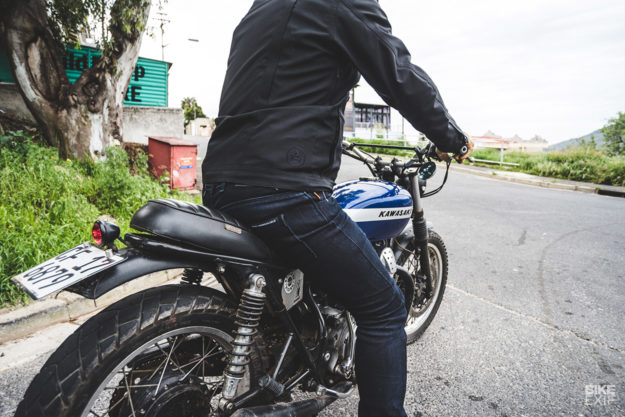
The overall styling is best described as urban workwear with a hint of adventure riding influence (hence, ‘Rally’). It’s a slightly longer cut than usual, with a slight drop in the tail for maximum coverage when riding. The main zipper is a heavy-duty, two-way affair—so you can open it from the bottom if the extra length bugs you while riding.
There’s a storm flap behind the zip, and an outer flap that seals up via press-studs. The attention to detail here is next level—each press-stud has a ‘loop’ behind it that helps you get a gloved finger in to snap it in place, and the outer bits are rubberized to prevent tank scratches.
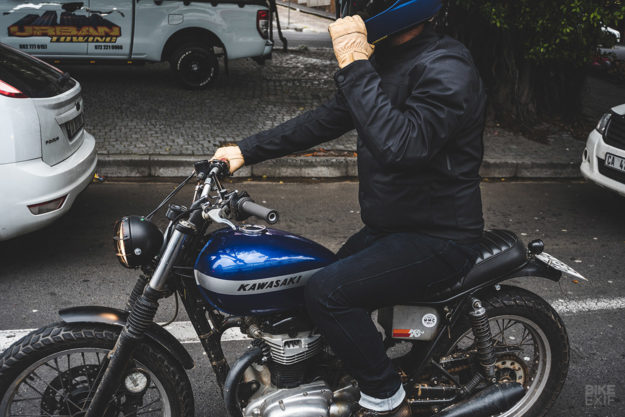
Aether tend to cut their gear for a more athletic build, so the Rally has a pretty slim fit, with no waist adjusters to tailor it. I sized mine according to my chest measurement, so it sits a little tight around my podgy gut, forcing it to pull up at the back a bit. If you’re pear-shaped like me, you might want to size up or consider other options.
Personally, I wouldn’t mind seeing some more give around the waist with some basic adjustment, but my guess is that Aether wanted to keep the overall layout as uncluttered as possible. A belt loop attachment—similar to the type REV’IT! supply on their Stealth hoody—would also be useful.
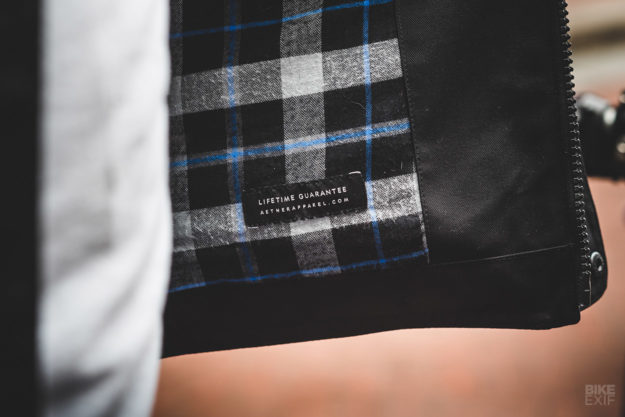
The outside of the Rally features a chest pocket, two zippered hand warmer pockets, and two press-stud pockets that seem to be purely for decoration. There’s a zippered Napoleon pocket on the inside too. Each pocket is lined with the same fabric as the main jacket body—a plaid cotton that not only looks amazing, but is ridiculously soft to the touch.
That little bit of extra refinement and comfort means that my Rally might even end up doing casual duty from time to time. It also doesn’t hurt that there’s barely any branding on it.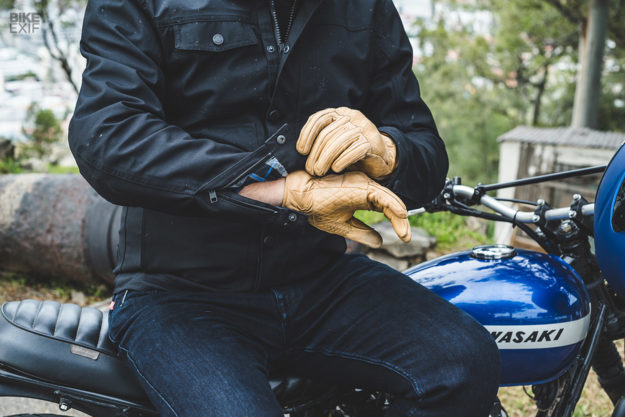
So it’s stylish, functional and comfortable—if you stay off the pies. But how many months of the year is it useful? My money’s on most, if not all, of them. Aether have kitted the Rally with long, dual zipper armpit vents (with tabs to make them easier to grab with gloves), and two exit vents at the back.
Spring has sprung down here, and I’ve already had the Rally out in some pretty toasty weather—as simple as the vent setup is, it’s highly effective for directing fresh air where you need it. And on colder days, I’ve found Aether’s claims of wind-resistance to be valid, simply adding a layer when temperatures really dropped.
Best of all, the Rally comes in three colors, one of which is black. Which, as we all know, goes with everything. [Buy]

Saint Stretch jeans We’ve profiled Saint jeans a few times here on Bike EXIF, and keep coming back to the Australian brand for one simple reason—their denim. Let’s recap: instead of layering their jeans with ballistic materials like Kevlar, Saint use a denim woven with an ultra-strong fabric called Dyneema. The result is single-layer (read: supremely comfortable) denim that’s highly abrasion-resistant.
Now they’ve taken the concept a step further, with a new stretch version of their ‘Unbreakable’ denim. By adding 2% Elastane to the mix, the jeans now have 180-degree stretch, but the fabric is still CE Level 1 approved. The claimed slide time/distance is four seconds/50 meters (160 feet). The jeans aren’t armored, so you’ll need to figure out where impact protection lies on your priority list.
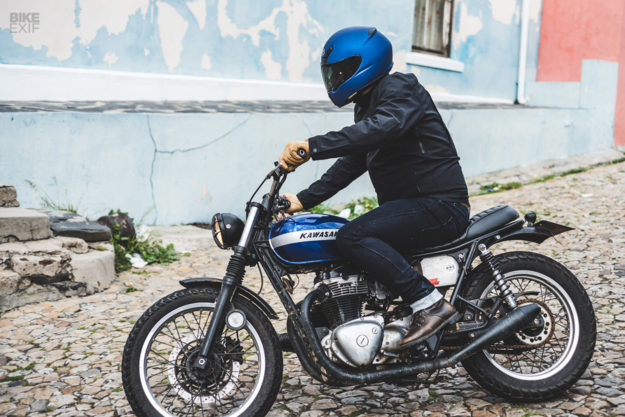
These jeans are cut to a very specific style that won’t appeal to everyone—and that’s OK. But stretch denim, generally speaking, is ridiculously comfortable. My go-to jeans are a pair of black stretch Levi 511s, and I’ve long wished for riding pants that felt the same. Like some genie from Down Under, Saint granted my wish.
The fit is slim but not too skinny, with a standard five-pocket layout, a tapered leg, a mid-waist and low rise. That last part means that they hang lower in the butt than what I like when I’m riding, but since the alternative is high-waisted dad jeans, I’ve learnt to just tuck in my T-shirt and get on with it.
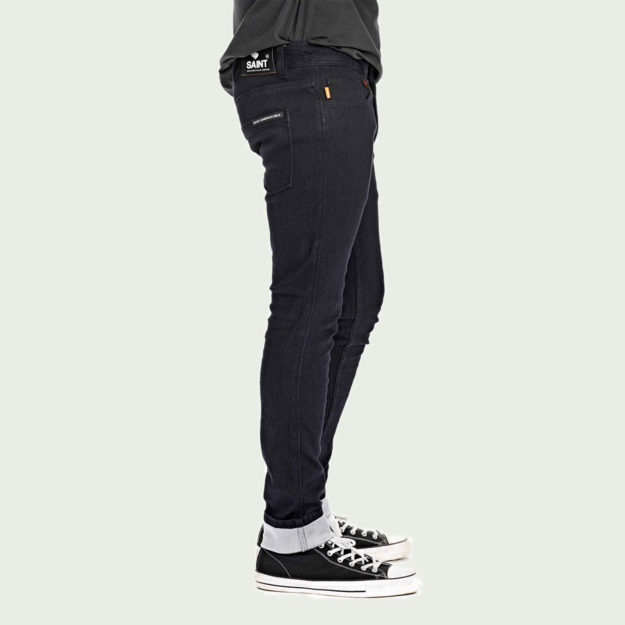
Size-wise, I’m a 38 in just about any jeans and these are no exception—except that Saint only make them in a 36 length, which means you’re going to end up cuffing them. They also break in quickly, and stretch almost a half size within the first few hours of wear, so consider sizing down if you’re on the cusp of two sizes.
If you like geeking out over denim, this next bit’s for you. Saint use 12 indigo and two black dye baths to dye the Stretch jeans, before washing each pair. They call the finish Jet Black Indigo which, in the flesh, looks exactly like you’d imagine: a really, really, really dark blue. I’ve been putting the hours into my pair on and off the bike, and I can already tell that they’re going to fade beautifully over time. General details are subtle, with minimal branding and a nice Saint ‘wing’ embroidered on the back pocket.

There are a couple of things bugging me though. I’ve already had to snip a few renegade threads, none of which have caused anything to unravel. But more concerning is that the zip has felt snaggy from day one, and I’m pretty sure I’m going to have to replace it sooner than I should need to. Considering the AU$399 price tag, I’m hoping these are just early run niggles, and not indicative of Saint’s overall quality.
That aside, Saint’s Stretch jeans are fast becoming my new go-tos. I’ve worn them more off the bike than on it, and when I am on the bike, their stretch qualities make for riding jeans that are supremely comfy, all day long. I think of them less as riding jeans that can pass for casual wear, and more as a great pair of denims that will hold up when things go random. [Buy]
Note: Saint will have these in two women’s cuts soon as well.
Photography by Devin Paisley.
